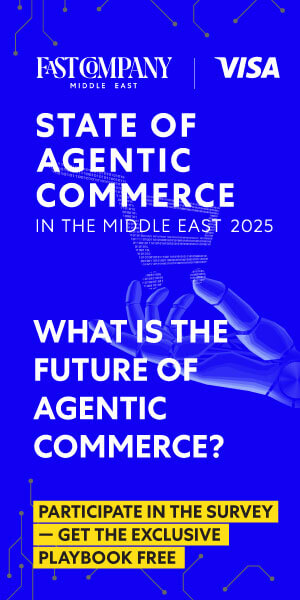- | 9:00 am
Adapt or disappear: The challenge that drives fintech innovation forward
Shifting consumer behavior, tech advances, competition, and talent availability are key drivers of constant reinvention in fintech.

The rapid rise of the digital economy, along with advances in tech and AI, has pushed many sectors to grow at an unprecedented rate, some sectors more than others. Fintech is one of the standout sectors continuously developing due to the need for constant innovation.
Fintech remains a dominant force in the MENA startup ecosystem, securing 30% of total funding—around $700 million—in 2024 alone, making it the region’s leading startup sector.
According to McKinsey & Co., the number of fintech firms in the region has surged past 1,000, the market producing four unicorns and attracting $1.9 billion across 237 deals in 2023 and 2024. MENA is projected to be the world’s fastest-growing fintech market, with annual net revenue growth of 35% through 2028.
As the sector expands, it also overflows, and competition intensifies. Startups are increasingly seeking differentiation, and the region’s fintech landscape is evolving beyond its traditional focus on payments, which once accounted for 85% of all solutions.
Today, companies feel the need to constantly innovate to avoid being left behind in an industry that is always chasing the next trend.
THE NEED FOR INNOVATION
Nauman Hassan, Regional Director MENA, Paymentology, says the constant need for reinvention in the fintech sector is a structural imperative driven by rapidly evolving technologies and rising expectations for access, speed, and personalisation.
“In a world where change is the only constant, the ability to reinvent quickly and meaningfully is what sets successful fintechs apart.”
Antony Sobhy, CEO of Trevi, identifies shifting consumer behavior as a major driver of this need for constant reinvention. “Users now expect ultra-personalized, real-time financial experiences. Static products no longer resonate with digital-native users.”
On the regulatory side, “new frameworks around digital identity, AI, open banking, and data privacy mean companies must continually adapt to stay compliant and competitive.”
Sobhy notes that with a saturated market, standing out requires more than new products. “It means evolving the entire value proposition.” Security is equally vital. “With more sophisticated fraud and growing reliance on APIs, innovation is key to maintaining trust. Reinvention is also about protecting the brand and user experience.”
Omar Saleh, Co-Founder & CEO of Khazna, attributes fintech’s constant reinvention to a range of factors, including shifting consumer behavior, evolving technology, regulatory changes, competitive market forces, venture capital dynamics, and talent availability.
“Meaningful fintech players need to be consistently learning, adapting and innovating given the rapid pace of change,” he says.
Saleh highlights Khazna’s approach, noting the company has dedicated teams monitoring technological trends and maintaining close ties with regulators to stay ahead of potential developments.
Fintech expert Ahmed Fahmy echoes this view, noting that rapid technological progress continues to push fintech firms to innovate and evolve. In the early days, he says, the industry responded to growing mobile adoption by embracing mobile wallets, providing users with a convenient and accessible payment option.
“The positive reception of digital payment technologies has whetted the appetite of other financial service providers to integrate technology into their operations,” he explains.
Fahmy points to emerging trends such as “InsurTech,” where technology is being used to develop dynamic pricing models, tailor insurance offerings, and speed up claims processing.
“Each new technological wave has acted as a catalyst for further innovation within the Fintech landscape,” he says.
Among the most transformative technologies, Fahmy highlights blockchain for its ability to bring transparency, security, and decentralization to financial services, and tokenization for its security, efficiency, and flexibility.
“The continuous evolution of technology promises further disruption and innovation within the Fintech sector, as companies strive to meet the evolving needs and preferences of consumers in an increasingly digital world.”
OUTDATED PRACTICES AND CHALLENGES
Financial Services Industry Veteran, Omar Haddad, notes some of the outdated practices that many MENA fintech companies struggle with.
“Many fintech players, especially those emerging from traditional financial institutions, struggle with legacy infrastructure that is not built for digital agility. Old Core banking systems, siloed data architectures, and manual KYC/onboarding processes.”
Haddad notes that while regular clarity is improving in the UAE specifically, some firms still rely on paper-heavy or semi-automated compliance practices. “This slows down innovation and responsiveness to market demand.”
Hassan, on the other hand, highlights fintech companies’ continued reliance on payments technology that was not purpose-built for the cloud.
“These systems are often inflexible, costly to maintain and struggle to keep up with a high rate of feature development. Without the scalability and resilience that cloud-native architecture offers, fintech companies find it difficult to keep pace with customer expectations or respond quickly to market shifts.”
Hassan also discusses legacy platforms as a key obstacle for fintech, noting their technical complexity, limited APIs, and lack of flexibility. These systems hinder collaboration, restrict personalization, and make it harder to deliver the seamless, tailored experiences today’s users expect.
“In a world where agility and personalisation are the cornerstones of competitiveness, clinging to legacy systems can quietly but significantly erode a fintech’s edge. It’s not just about technology – it’s about staying relevant.”
Meanwhile, Fahmy discusses how companies often focus on profitability or market share, shaping strategies around these goals. As a result, they may overlook innovation, assuming creativity is unnecessary once targets are met and growth appears satisfactory.
“However, they neglect the critical understanding that a cessation of development and innovation can expose them to the risk of losing their market share or being entirely eliminated from the competitive landscape.”
Fahmy cites cost concerns as a key reason some companies avoid innovation, fearing short-term profit loss. He adds that limited access to skilled talent—and the high cost when available—is a major challenge, especially for smaller fintech firms.
Similarly, Antony Sobhy, CEO of trevi, cites monolithic rigid platforms, siloed data systems, manual processes, and legacy partnerships as some of the most common outdated practices that stand in the way of fintech innovation.
“Perhaps the most limiting is the mindset. Some fintechs fall into the trap of repeating what worked before, rather than embracing change. A fixed mindset, where experimentation is seen as risky rather than essential, will always hinder innovation, no matter how good your product is,” Sobhy states.
KEY STRATEGIES
Saleh says a culture of innovation has to be deliberately built by industry leaders.
“This requires the commitment of the individual leaders to treat innovation as a core metric for the company. Failure has to be accepted and even celebrated as long as learnings are understood and applied,” he explains, adding that fintech companies should also look globally for like-minded innovative players to share ideas and learnings and push the boundaries of innovation together.
Haddad emphasizes that innovation should be embedded into the core of how companies operate. This includes establishing internal innovation labs to experiment with new ideas, leveraging regulatory sandboxes from ADGM and DIFC to safely pilot products, and adopting agile methodologies to enable speed and continuous improvement.“Partnerships also play a big role—whether with banks, telecom companies, government bodies, or global tech firms—to help scale faster and deliver more value,” he adds.
Equally critical, Haddad notes, is building the right team. Fintechs need talent with diverse skill sets, particularly in product design, data, and cybersecurity. He also stresses the importance of leadership setting the tone by prioritizing innovation and promoting smart risk-taking throughout the organization.
“Innovation is not just about features. It’s about creating an internal culture that’s built to adapt, iterate, and lead change,” says Sobhy, outlining several key practices to foster this mindset.
He emphasizes the value of customer-centric experimentation. “Every product update should be grounded in real user behavior. Companies that use AI-driven analytics to identify friction points and rapidly prototype solutions tend to move faster and with more impact.”
Sobhy also points to the rise of agile, modular systems: “We’re seeing a big shift toward composable fintech, where you can plug in or swap out capabilities like KYC, lending, or payments without rebuilding the core product.”
Cross-functional collaboration is essential, he notes, along with fostering an internal R&D and hack culture. Encouraging teams to explore emerging trends such as tokenized assets, CBDCs, or AI-driven credit scoring—through dedicated R&D time or internal hackathons—drives innovation without the immediate pressure of results and can be transformative.
EMERGING TRENDS
Haddad highlights several transformative trends shaping the future of fintech, starting with AI and machine learning, which he says are making it faster and smarter to onboard customers, detect fraud, and assess credit—particularly for those with limited access to traditional banking in the MENA region.
He also points to the rise of open banking and finance, as well as Central Bank Digital Currencies (CBDCs) like the UAE’s Digital Dirham, which could change how money moves. Embedded finance is another key development, allowing non-financial companies—such as retailers—to offer banking services directly, improving access without relying on traditional banks.
Haddad also notes the growth of Islamic fintech, which is creating digital products aligned with Sharia principles to serve customers often overlooked by conventional fintech.
Meanwhile, Hassan says that advanced payment technologies are already reshaping the sector. “Digital banks, such as Wio Bank in the UAE, allow customers to issue virtual and physical cards with budgets that can be pre-configured down to specific spending categories. This level of configurability gives consumers and businesses unprecedented flexibility and oversight.”
He adds that tokenization is another breakthrough, enhancing transaction security and lowering fraud risk—crucial in today’s trust-driven digital economy.
“But the real transformation will come from deeper collaboration. Partnerships between regional financial institutions and global fintech innovators are key to creating platforms tailored to local market needs. These alliances will be the driving force behind scalable, inclusive, and sustainable fintech ecosystems across the region.”






































